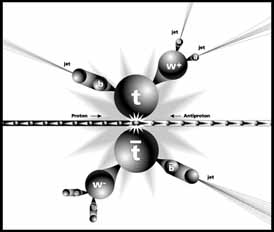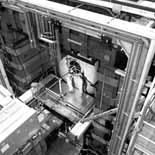 |
|
Physics in Plain English by Judy Jackson
One of the most sustained efforts to translate the arcane language of particles, probabilities and picobarns into language the rest of us can more or less understand comes from Fermilab's DZero experiment. In 1997, the collaboration launched "Plain English Physics," DZero's commitment to explain their experiment and its scientific results in simple language. Three years later, the collaboration has persevered, despite the considerable challenge of putting forefront physics into low-jargon prose. Most recently, with the leadership of Fermilab physicist Boaz Klima, DZero has published "Physics Highlights of the DZero Experiment, 1992-1999" on the World Wide Web at http://d0server1.fnal.gov/projects/results/runi/highlights/runi_summary.html The following excerpts from the 20-page "Highlights" discuss DZero's work on the top quark. Other sections, accessible on the Web, describe the detector, electroweak physics results, quantum chromodynamics, the physics of the bottom quark, and the search for physics beyond the standard model. Physics Highlights of the DZero Experiment, 1992-1999 The DØ experiment was proposed for the Fermilab antiproton-proton Tevatron Collider in 1983 and approved in 1984. After 8 years of design, testing, and construction of its hardware and software components, the experiment recorded its first antiproton-proton interaction on May 12, 1992. The data-taking period referred to as "Run 1" lasted through the beginning of 1996. Collisions were studied mainly at an energy of 1800 GeV in the center of mass (the world's highest energy.... All results summarized below are based on these data, and on the dedicated and imaginative efforts of the undergraduate and graduate students, postdoctoral fellows and senior scientists involved in the program. Currently, the DØ Collaboration consists of more than 500 scientists and engineers from 60 institutions in 15 countries (see some of them in Fig. 1). Over 110 Ph.D. dissertations have been written so far on various aspects of DØ, and more are anticipated over the next two years, as the analyses of data from Run 1 wind down, and the next run, with both an upgraded detector and improved accelerator, commences. Among the highlights from Run 1 described in the following sections are the discovery of the top quark and measurements of its mass and production cross section; the precise determination of the mass of the W boson and the couplings of the electroweak bosons (photon, W and Z); numerous searches for new physics; measure-ments of bottom quark production; and extensive studies of the strong "color" force, quantum-chromodynamics (QCD). We have already published most of our results from the past six years; to date, over 80 papers have appeared in refereed journals. In addition, our publications are reprinted in annual collections that are available from the library at Fermilab. The published papers, as well as work presented in conferences, can be accessed from our web pages (see http://www-d0.fnal.gov/). ... We have also prepared "plain English" summaries, intended for a more general audience, that can be found on the web at http://www-d0.fnal.gov/public/pubs/d0_physics_summaries.html.
Physics of the Top Quark
From the beginning, the search for the top quark was a very high priority at DØ. The Standard Model was explicit in predicting top-production and decay characteristics. Specifically, the production rate for top-antitop pairs could be calculated reliably from on QCD theory, once the top-quark mass was specified. Similarly, the decays of a top (or antitop) quark could be predicted because the top was expected to decay nearly all the time to a W boson and a b quark, giving rise to a final state with two Ws and two b-quark jets. The decays of W bosons (either into charged leptons and their neutrinos or into quark-antiquark pairs) were already well established. Thus the basic classes of final states arising from top and antitop production were the following: (a) six quark jets (four from the Ws and two from b quarks); (b) a lepton and neutrino, accompanied by four quark jets (two from one W and two b jets); or (c) two leptons and neutrinos and two b quark jets (see the diagram in Fig. 5). Other final-state particles were expected from the interactions of the rest of the quarks and gluons in the colliding proton and antiproton, and also from the radiation of gluons from the interacting quarks. Neutrinos could be sensed only through the missing transverse momentum in the detector. Tau leptons are difficult to identify, and conse-quently the electron and muon channels turned out to be the preferred channels for studying leptonic final states.... The first portion of Run 1 (Run 1a) was completed in mid-1993 and yielded an accumulated collider luminosity corresponding to 14 events per 1 pb of production cross section (usually referred to as 14 pb-1). From these data, DØ published its first search for the top quark in early 1994, using the single lepton, electron (e) and muon (m) channels, and the ee and em channels. The selection criteria were set to optimize the discovery of a top quark with a mass of about 100 GeV. Three events were found: one em candidate, one ee candidate and one single-electron candidate, all with accompanying jets. The expected backgrounds were comparable to the number of observed events. Hence, a lower limit of 131 GeV at the 95% confidence level was set on mass of the top quark, based upon the SM calculations for the expected yield as a function of mass. This was the highest mass limit at the time (and, as it turned out, the last lower limit reported on the mass of the top quark!). There was a spectacular event ("Event 417") in this sample, containing an electron, a muon, and missing transverse momentum, all above 100 GeV, together with two well-identified jets and a small third jet. The probability for background processes to produce this event was extremely small. Our publication reported an analysis of the mass, based on the assumption that this event was a top-antitop production, stating that: "The likelihood distribution is maximized for a top mass of about 145 GeV, but masses as high as 200 GeV cannot be excluded." This event survived subsequent signal-selection criteria that were even more restrictive and ended up in our final Run 1 top-quark sample. With this mass limit in place, and in anticipation of much larger data samples from Run 1b later in 1994, DØ optimized the search for top at higher masses, and developed powerful techniques for determining its mass....
In late spring of 1994, the CDF experiment submitted for publication a publication showing evidence that the top quark may exist, with a mass near 175 GeV. The CDF excess of events corresponded to a cross section of more than a factor of two above the expected (and currently accepted) value. Although suggestive, these data were insufficient to claim discovery. At the same time, DØ presented its updated results at conferences.... The sensitivities of both the CDF and DØ experiments to possible top signal were very similar, but the DØ sample contained only a modest excess over background estimates (7 events with an expected background of 3.2 events), and the top-antitop production rate inferred was consistent with that predicted (and now confirmed) by the Standard Model.
At the beginning of 1995, data samples had increased by a factor of nearly three. On February 24, 1995, DØ and CDF simultaneously submitted papers announcing the discovery of the top quark. The DØ sample had 17 events with an expected background of 3.8, and the odds for the background to fluctuate to the observed sample were only 2 in 1 million. For this sample, the mass of the top quark was estimated to be between 167 and 231 GeV. The cross section was measured to be 6.3 ± 2.2 pb for a mass of about 200 GeV. The CDF results were consistent with those from DØ, favoring a somewhat larger cross section and a lower mass. The discovery of the top quark completed the roster of SM particles comprising matter, and underscored the special nature of the top quark ó an elementary particle as heavy as a gold atom, and with a mass commensurate with the energy scale of electroweak symmetry breaking. These CDF and DØ papers on the discovery of the top quark have now become the second most cited result in experimental high energy physics (after the papers on the J/psi discovery). By the end of Run 1 in early 1996, DØ had recorded about 125 pb-1 of data. From the full data set, several more improvements were made in understanding the top quark. Searches for anomalous behavior in top production were sought, but none found. Searches for new particles in top decay, such as charged Higgs bosons, came up empty-handed. But several important advances were made in the measurement of the top-antitop production cross section and the mass of the top quark. .... The combination of all analyses of the top-antitop cross section yielded 5.9 ± 1.6 pb, for a top mass of 172 GeV, in excellent agreement with the theoretical prediction from QCD. The mass analysis was improved in several ways. ... [T]he final top mass from DØ analyses is 172.0 ± 7.1 GeV (an uncertainty of about 4%), far exceeding the initial expectation for precision, and making the top mass the most precisely known of all quark masses. Combining all mass measurements from both CDF and DØ, yields a mass of 174.3 ± 5.1 GeV (< 3% uncertainty) for the top quark. The discovery of the top quark was a major achievement and the highlight of the DØ program in Run 1. Its very large mass suggests that it may well play a special role in the breaking of the electroweak symmetry, and could be partially responsible for the mechanism by which all particles acquire mass. It provides a probe for seeking new forces in which top and antitop quarks combine (annihilate) to make new particles, and a vehicle for the search for new massive particles in its decays. These are the themes that will dominate top-quark studies in the forthcoming Run 2, where at least forty times more top events are expected in a substantially improved detector with greater capability for deciphering these complex signals. |
| last modified 3/10/2000 email Fermilab |
FRLsDFx9eyfrPXgV
 Communicating physics is like the weather in Mark Twain's well-worn phrase: everybody talks about it, but nobody does anything about it. In the case of physics, however, there are a few exceptions.
Communicating physics is like the weather in Mark Twain's well-worn phrase: everybody talks about it, but nobody does anything about it. In the case of physics, however, there are a few exceptions.

